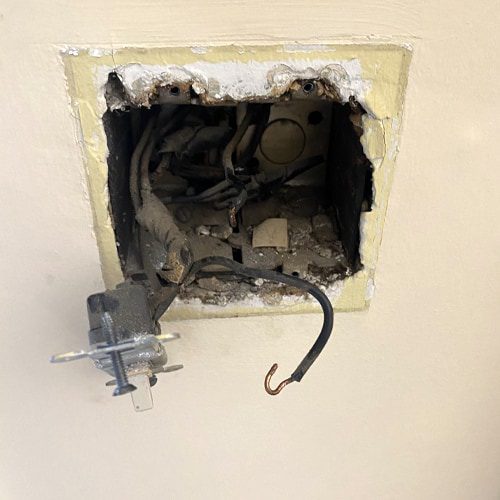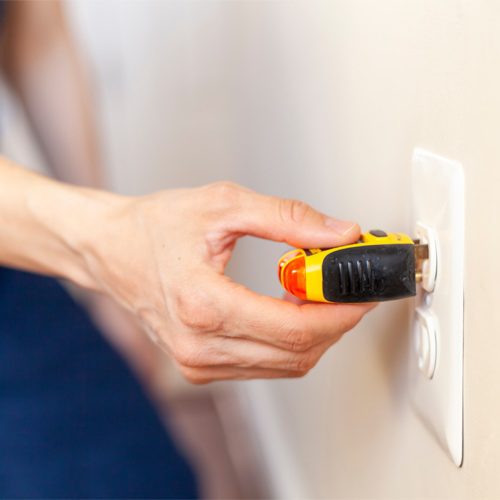How to tell if a light switch is bad
Light switches seem to be one of those few home appliances that last forever – generally only getting replaced when style dictates. However, forever is a long time, and even though they’re durable, light switches will inevitably need to be replaced.
The good news is there are fairly clear warning signs of a failing light switch, letting you know when you’ll need to replace it. And, it’s important to be able to recognize these signs, as a faulty light switch poses a fire hazard in addition to being frustrating to use!
What causes a light switch to go bad?
Light switch toggle levers physically make and break electrical connections by moving the contacts back and forth. Over time these moving parts are subject to wear from friction – possibly resulting in electrical arcing. This arcing accelerates the wear, ultimately leading to a complete failure of the unit.
What are the signs a light switch is about to go bad?
Lights Flicker
If your light fixtures begin to experience flickering that can’t be remedied with a new light bulb then you may want to consider a failing light switch as a possible culprit. This problem can also be caused by a loose connection in the switch or at the fixture itself, so rule these out before replacing parts arbitrarily.
Sparks coming from switch
Tiny sparks are not uncommon in switches, but large sparks are cause for concern. Sparking is caused by load arc, where the electricity bridges the gap between the contacts as they are moving together or apart. However, if these sparks are new or have gotten noticeably bigger, then you need a new light switch.
Sometimes you may not be able to see the sparks directly – if you smell smoke or see any signs of scorching on the cover plate then the switch needs to be replaced.
Noisy Switch
When wall switches are working correctly they will switch with a quiet snap or click. If your switch crackles or buzzes that is a clear sign of an electrical problem that needs to be fixed.
Switch is warm to the touch
If your switch is warm to the touch, and isn’t a dimmer switch, this is a sign that your wall switch is failing. This can indicate a short circuit and should be addressed quickly. Electrical fires are a serious risk and electrical problems are not the type of home repair that can be put off.
How to test for a bad light switch
If you suspect your light switch is failing then you can quickly confirm this by testing it with a digital multimeter.
First, you need to disconnect the power to the switch at the circuit breaker. Next, remove the switch cover to expose the electrical receptacle.
Set your multimeter to test for Continuity or to its Ohms setting. Touch the meter’s probes together to ensure the device is calibrated and working properly. With the probes touching your meter should read 1ohm or less. A higher reading or OL means the meter is not operating correctly.
Next you’ll need to identify which wire connections you’ll need to probe. There are two common types of switch wiring: single-pole and three-way switches. If multiple switches control a single fixture then you are working with a three-way switch, otherwise your switch is likely single-pole.
A single-pole switch will have two side terminal screws and possibly a ground wire located at the top or bottom. Put one of your multimeter’s probes on one side terminal and the second on the other. With the switch turned on your multimeter should read 1 ohm or less. A higher reading indicates a problem with the switch.
A three-way switch will have three terminal screws on the side, plus a possible ground wire. One of the side terminals will have a dark screw, indicating the common connection. The other two terminals will share a screw color and are each the traveler wires.
Put one of your probes on the common terminal and the other on one of the two travelers. If your meter does not register the connection (often displaying OL) try the other connection or move the switch. When powered on, each of the travelers should show less than 1 ohm resistance. Make sure to test both!
While the electrical box is open, this is a great time to check for loose wires. Use your screwdriver to tighten the terminal screws and ensure that your wires are well seated before reinstalling the switch.
If you don’t have a multimeter available for troubleshooting you may wonder if you can use a non-contact voltage tester or continuity tester instead. Non-contact testers are good for verifying whether or not a circuit is still energized, but unfortunately will not allow you to determine if electrical repairs are necessary.
A continuity tester can determine if a connection is still good, and will be used the same way as a multimeter set on its Continuity/Ohms setting. When connected across a closed circuit the continuity tester will signal the circuit is working by illuminating a light or engaging a buzzer.
If you aren’t confident about going the DIY route for electrical repairs or don’t have the right tools, contact a professional electrician.
Bad switch, but easy fix
In the grand scheme of things, a failing light switch is an easy problem to fix. Despite being quite robust, these tools have metal parts that will eventually wear down and need replacing. You’ll know when that time comes by watching out for flickering lights, sparks, unusual noises, or if the switch becomes warm to the touch. If you notice any of these symptoms, it is time to break out your multimeter or contact your neighborhood electrician!


